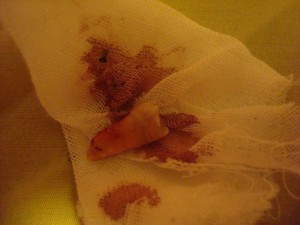Once the Extraction is Complete
Using your other hand for support, the remainder of the root will also have to be extracted using the periosteal  elevator instrument. When finished, place gauze on the socket and instruct the patient to gently bite down. This prevents excessive bleeding. Sutures may be required in instances where bleeding is heavier than what is deemed normal. A Cuban study also found super glue (N-butyl-2-cyanacrylate) successful in treating both pain and excessive bleeding.
elevator instrument. When finished, place gauze on the socket and instruct the patient to gently bite down. This prevents excessive bleeding. Sutures may be required in instances where bleeding is heavier than what is deemed normal. A Cuban study also found super glue (N-butyl-2-cyanacrylate) successful in treating both pain and excessive bleeding.
Some swelling, bruising and pain may occur in the hours and days after the extraction. Cold packs can help lessen your chances of swelling 24 to 48 hours after the tooth removal. You can also place warm compresses over the jawline to decrease stiffness and pain.
Non-steroidal anti-inflammatory pain relief such as ibuprofen can help alleviate the pain afterwards. Since aspirin may hinder the blood clotting process, it’s recommended that patients avoid using this painkiller. Patients should also avoid smoking, spitting or using a straw to drink out of as the pressure could dislodge the blood clot, causing what is known as a dry socket condition. Warm salt water gently rinsed around the mouth area or antibiotics can help reduce pain.
Never perform a dental procedure on someone for any reason if you have modern dental care available to you. In a nutshell, it’s best to leave it to the professionals in normal situations – even if you resent funding your dentist’s latest sports car that’s sitting in the parking lot when you go to your appointment. The lack of schooling and professional dental training may cause serious complications to arise that are much worse in to deal with than a bum tooth. If you have access to a knowledgeable and experienced dentist, it’s best to seek their service out.
Photo by Spider.Dog
